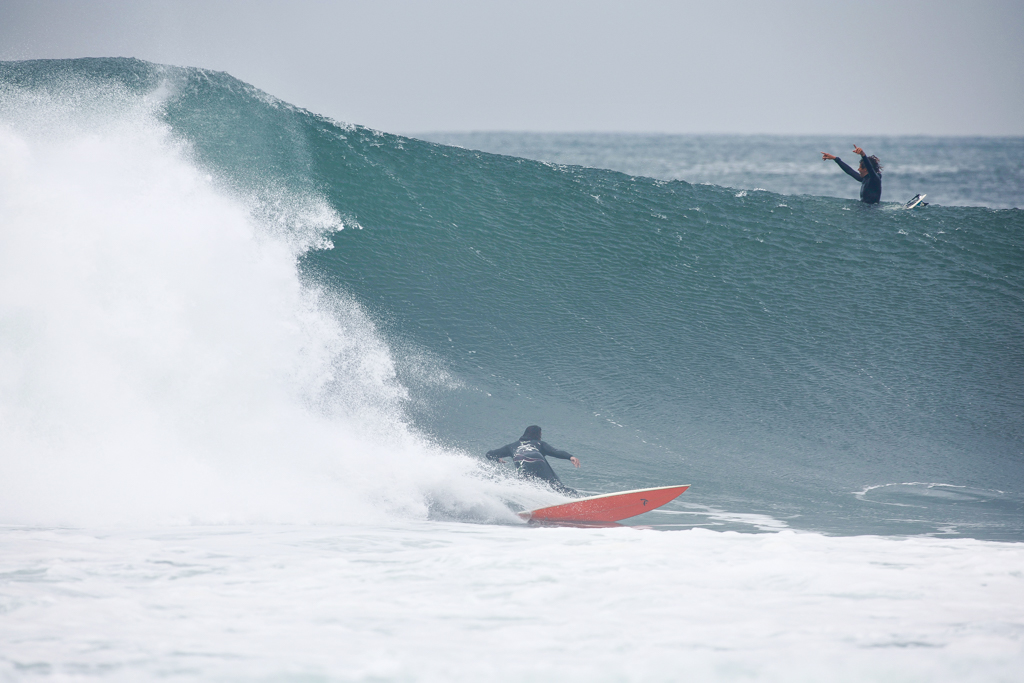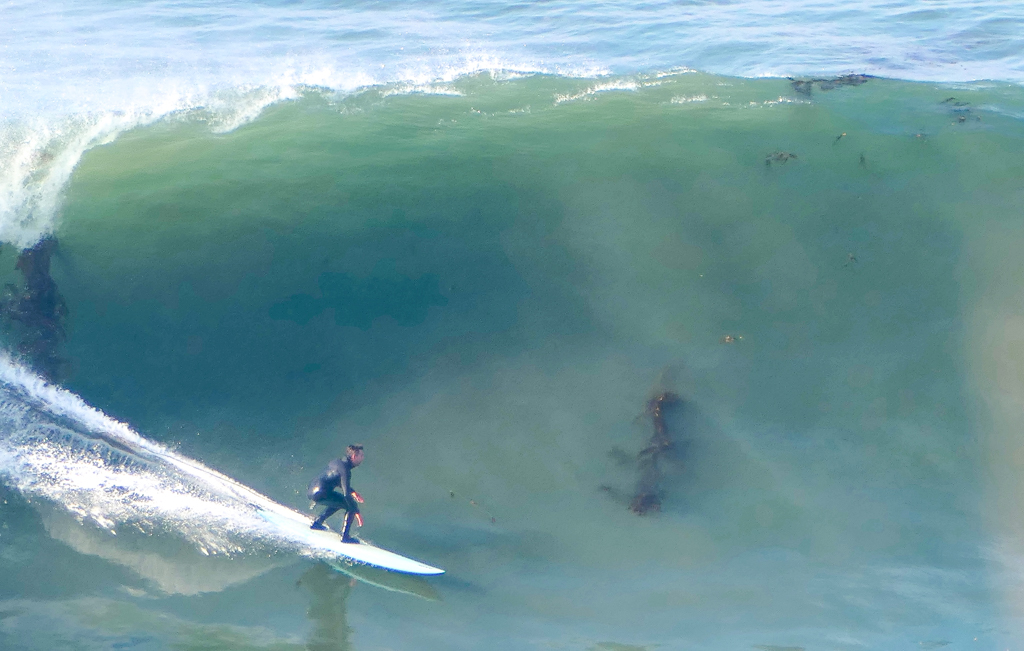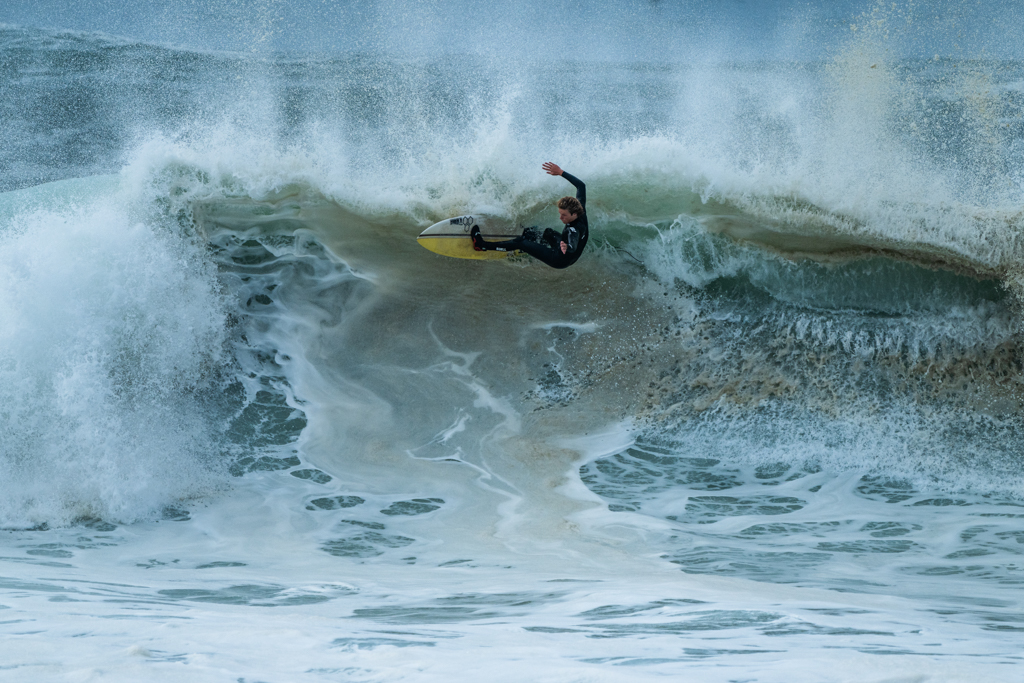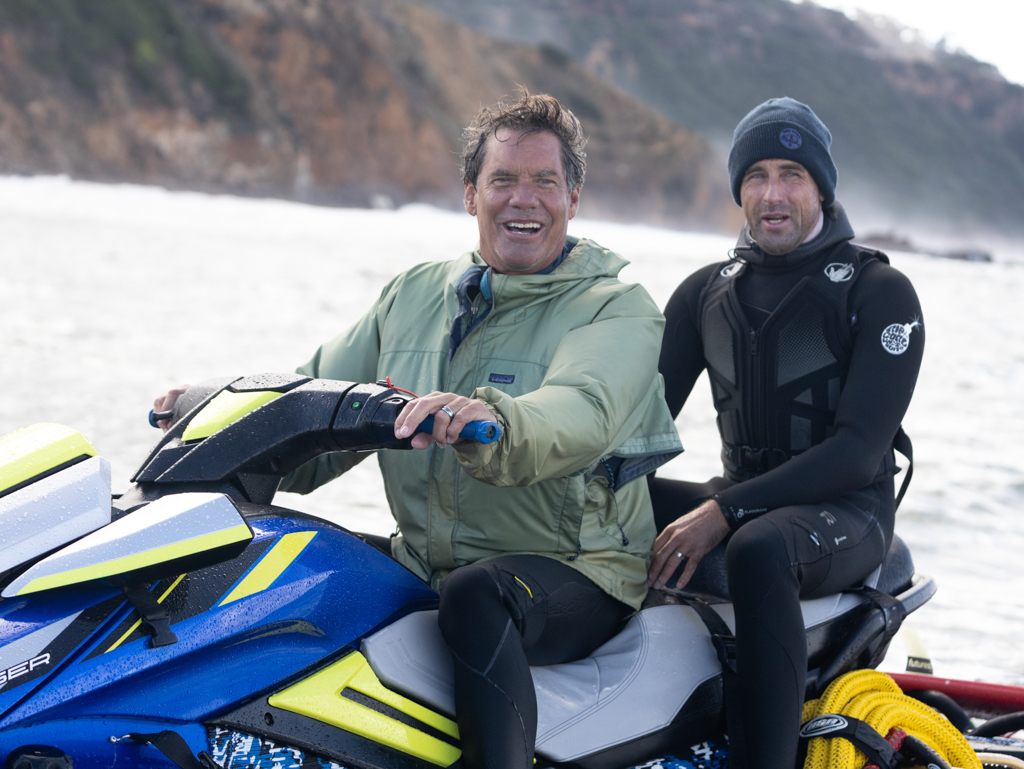by Kevin Cody
The swell that hit South Bay beaches last Thursday invites comparison to the swells that flooded the Hermosa Strand in 1983; blew a hole in the Redondo Breakwall, and blew out the windows of the Portofino Hotel in 1988; and breached the breakwall again in January of this year, destroying the King Harbor Yacht Club’s docks, and parking lot, and the cars carelessly left in the lot overnight.
Waves broke 100 yards out from the Hermosa and Manhattan piers last week, forcing their closures. The Redondo Beach bike path was flooded. In King Harbor, the Harbor Patrol had to chase down loose boats. A fisherman knocked off the breakwall and knocked unconscious would have drowned if three stand-up paddlers hadn’t pulled him from the water. The oil tankers moored one and a half miles off of El Segundo were moved five miles out to sea.

Wave energy is measured in KJs (Kilo Joules). A 100 KJ is powerful enough to surf. Thursday’s measurement, according to Surfline, was 2,600 KJs.
The people who most care about how the swell during the final four days of 2023 compares to past swells are the people who surfed the swell. Judging from what they say now, they will be talking about it a long time.
Kip Jerger was a Los Angeles County Lifeguard in 1983. During that January swell he caught a wave at Indicators in Palos Verdes that earned him and fellow surfer Sal Ferraro a full page photo in Surfer Magazine. They look like dots at the top of the 20-foot plus wave.

Last Thursday, Jerger looked at Indicator, and it looked bigger than he remembered in 1983. Nick Ferrera, Sal Ferrera’s nephew, and professional big wave rider Scotty Bredesen, whose dad Chris is a former professional surfer, were riding 9-foot guns. Jerger, now 70, gave it a pass. Instead, he surfed a still formidable 12-foot Exiles, around the corner, to the north of Indicators.
Chris Wells, 55, has surfed the Redondo Breakwall since he was in junior high. Like Jerger, he thinks last week’s swell was the biggest he has ever seen, though his opinion might have been influenced by an ankle sprain he suffered last Thursday.
When Breakwall surf is too big to paddle out through, surfers walk out along the Breakwall rocks. When there is a lull between waves, they scurry down the rocks, and jump in the water. But Thursday’s waves were so consistent, there were no lulls. Wells, and fellow Breakwall surfer Brett Madden, ducked behind large rocks to avoid the waves. Then Wells slid down to a flat rock he regularly uses as a jumping off point. His ankle buckled and another wave swept him back up the rocks.
“I was wearing a helmet for the first time because, as I get older, I don’t care if I look like a kook. I’m glad I wore it. I kept hearing it go tap, tap tap on the rocks,” he said.
The same waves left Madden with a sprained knee. But both made it out to the lineup and surfed the better part of the day.
“It’s like a car accident. You don’t feel the pain until a few hours later,” Wells said. On Friday, neither Wells, nor Madden were able to surf.
Only a few other surfers were out Thursday, among them Breakwall regulars Charlie Carver, Brett Rubin, Jeremy Griffin, Noah Collins and Luhrson brothers Angelo, Luca and Chace.
In comparing last week’s swell to previous big swells, Wells said, “Everyone I talked to thought the same thing, that there was just a lot more water moving around than in past years. Usually waves here aren’t like in Hawaii, where they step ladder up through the day. Usually local swells take a few days to build. I thought the forecast for really big waves was hype until it went from maybe 10 feet to 25 feet in just a few hours,” he said.
Friday, Breakwall was equally good. The same crew was out, minus Wells and Madden.
Saturday, no one went off the Breakwall rocks. It was painted in whitewater.
Derek Brewer, who prefers paddling to jumping off the rocks, anyway, tried paddling out. He was eager to surf because he was skiing in Mammoth Friday and Saturday.
After 10 minutes of paddling, he wasn’t 10 yards off the beach, and the current next to the rocks that usually carries paddlers out, was steering him into the rocks.
“Saturday was the only time I’ve ever not been able to paddle out at Breakwall,” Brewer said. He is 50, and has been surfing Breakwall since his teens.

Alex Fry had been in San Diego surfing 15-foot Blacks when the swell hit Thursday, and like Brewer, he was determined to surf at the Breakwall on Saturday.
“I showed up at daybreak, and saw Derek trying to paddle out. The waves looked good, and no one was out. I wanted to give it a shot,” Fry said.
Charlie Carver, another Breakwall regular, recalled decades past, when surfers paddled out from the harbor. He paddles for the Lanakila Outrigger Club and suggested to Brewer and Fry they launch from the club’s dock.
“I already had my suit on,” Brewer said.
The two walked in their wetsuits a mile south along Harbor Drive to the hand launch behind Seaside Lagoon and jumped in the water. From there they paddled out of the harbor, and north to where the breakwall turns toward the beach. Enroute, they stayed wide because waves were breaking over the breakwall. It was more like swimming than paddling because their 6-foot-9 boards had barely enough volume to float them. The mile and a half paddle took 45 minutes.
“It was worth it, but I don’t think I’ll do it again,” Fry said.
Upon arriving at the Breakwall, they surfed another 45 minutes. Both caught four waves in the 15- to 25-foot range. Brewer got out because he rode a wave in too far, and wasn’t able to paddle back out. Fry got out because he took a wave on the head and his board snapped. He snapped another board at the Breakwall on Sunday.

The biggest waves ridden during the recent swell went undocumented. They were two miles off El Segundo, out of range of the photographers and videographers.
“People ask if we surfed Tanker Reef. I tell them no. We were out past Tanker Reef,” Bob Sievers, a Manhattan big wave rider said.
Tanker Reef is the Chevron Marine Terminal, where oil tankers hook up to pipes leading to the El Segundo refinery. The terminal is one and a half miles off shore in 50 feet of water. Thursday afternoon, as a precaution, the tankers were moved five miles out to sea to the federal anchorage.
That’s when Sievers and tow-in partner Pat Miller put their PWC in the water at the King Harbor boat hoist. Sievers has surfed big waves for years at Mavericks. Miller’s big wave experience includes Nazarene, Portugal, home to the tallest waves ever ridden.
Sievers compared his Thursday experience to Hawaii’s outer reefs, except the outside Tanker Reef is sand, and admittedly mushier than Hawaii’s top-to-bottom lips.
“We got there about 1 p.m. They were moving the freighters out because waves were breaking there. So we went further out,” he said.
Sievers called it “a 100 year storm.”
“Waves were three to five, sometimes six times overhead, the biggest we’ve ever ridden out there. We rode them as far in as the red El Segundo Jetty buoy. Past the buoy, and we wouldn’t have been able to paddle back out, and taking the Jetski in would have been sketchy.”
On Saturday, Sievers and Miller rode their PWC to Palos Verdes. They were followed in Andre Klaser’s 20-foot RIB (Rigid Inflatable Boat), with retired lifeguard Scott Davey, and an Easy Reader photographer. Sievers and Miller looked at an empty Exiles and Indicators, but the high tide, and stormy water made the waves unrideable.
On Sunday, the sun came out, conditions cleared up and Sievers and Miller returned for a session at outer Tanker Reef.
But Sunday’s sun and clean conditions didn’t make paddling out from the beaches any easier.
Johnny Herrouin is a freshman, and Cole Saffel a junior at Mira Costa. Both are on the Costa surf team and grew up competing in the South Bay Boardriders surf contests. (The Boardriders also sponsor the annual South Bay Big Wave Challenge. It runs December through March.)
Sunday morning Herrouin, Saffel and fellow Mira Costa surf teammate Alex Biggs set off on their bikes for Hammerland, just morth of the El Segundo Jetty.
Hammerland looked too rough to paddle out in. A block north at Grand Avenue, they saw a cluster of photographers.
It also looked impossible to paddle out there to0, but there were people out.
They saw Los Angeles County Lifeguard Shane Gallas, a past winner of the Big Wave Challenge, come out of a spitting barrel.
An on duty lifeguard told them they wouldn’t make it out.
“I got lucky the first time paddling out. It only took a few minutes. But the four other times took 10 minutes or more,” Herrouin said.
Saffel and Biggs also made it out.
“It was nerve racking. Sets were an easy 12-feet, and heavy, hollow, top to bottom,” Saffel said.
But once they made it out, the young teens showed they deserved a place in the El Segundo line up. Photographer Steve Gaffney caught 15-year-old Herrouin committing to a suicidal lip smack on a frothy 10-foot wave (See photo page 2).
Back at the Breakwall Sunday morning the old guard was putting on a clinic for the new guys.
Wells and Madden were back, despite their wobbly legs.
The three Luhrsen brothers, Angel, Luca and Chace were out, moving into the spot once occupied by their dad Michael, and uncles Jude and James.
Charlie Carver was back, after surfing the Breakwall Thursday and Friday. Like Wells, he is 55. He started surfing at the Breakwall with his dad when he was 5, on a Boogey Board. He was surfing a 7-foot-4 Bill Higley with glassed on fins.
“I take it down from the rafters every winter,” he said.
Sunday was the best he’s ever seen Breakwall, he said.
“I sat a while on the rocks just watching. It didn’t look like Breakwall. I mean real Breakwall. Waves were breaking out by the sailboat racing pin. Square, stand up barrels that went all the way to the storm drain, north of the Charthouse,” he said.
Matt Meistrell, 41, is also a second generation Breakwall surfer. His dad Randy, and uncles Robbie, Billie and Ronnie all grew up at the Breakwall, a few blocks from the family’s Dive N’ Surf, where Matt’s grandfather and greatuncle Bob and Bill invented the modern wetsuit.
“Most years, we’re hoping the surf gets bigger. But this year, it was almost too much energy. It was also so consistent it was hard to jump in off the rocks,” he said.
“Sunday, Charlie, Brett and I were there at sunrise. It didn’t look big, maybe six feet. But out on the rocks, we knew it was bigger than it had looked. It took forever to get off the rocks. There were 10-foot barreling freight trains with no one on them.
“As crowded as surfing has gotten, it was nice to see great waves still go unridden.”
Meistrell equivocated when asked if last Sunday was best he’s ever seen Breakwall.
“It’s hard to judge. There was a run in the early 2000. But it was up there,” he said.
One thing he and fellow surfers did agree on. The surfer who wins this year’s South Bay Boardriders Big Wave Challenge will be the surfer who caught the biggest wave during the last four days of December. ER








